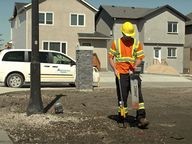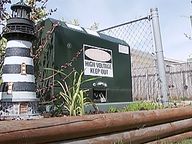Before you start landscaping, or add a pool or fire pit, consider the location of above ground power lines, and underground electrical and natural gas lines.
Click before you dig
If you plan to dig more than 15 cm, click before you dig. We will check and mark your property for electric and natural gas lines. The service is free.
Smart Ideas: Click before you dig
If you’re planning a project that requires you to dig more than 15 cm, it’s important to Click Before You Dig to make sure there are no underground gas or electrical lines.
If you hit an electric power line or natural gas pipeline, you can cause severe injuries or death, and damage or destroy your property.
Trees and power lines
Before you plant a tree, look up.
- If your tree looks like it will touch an overhead power line as it grows, find another location.
- Keep all plantings to a minimum of 2 metres back from a power line.
- Plant taller growing trees like willow, ash, maple, evergreen at least 6 metres back from a power line.
Your safety watch: Tree trimming
Trees growing close to power lines can be fire hazards or bring down power lines. It’s best to hire a certified arborist to trim or prune trees on your property.
When trees touch power lines, they can cause power interruptions, blackouts, and fires. If trees begin to pose a risk, they may be radically cut back or removed. Find out more about your tree trimming options.
Call us at 1-888-624-9376 (1-888-MBHYDRO) if:
- you see a tree touching a power line;
- you have questions about tree trimming on your property.
Guide booklets
- Right Tree — Right Place (PDF, 2.8 MB)
Choose the best trees for your location with this planting guide. - Tree Care — Planting and maintaining your trees (PDF, 1.4 MB)
Proper planning, planting, and maintenance are key for growing healthy trees.
Managing plants and trees around our equipment
To maintain reliable service, we remove and trim trees and plants along 90,000 km of power lines. We work to reduce the impact to a healthy tree canopy while keeping a safe clearance for our workers.
Power lines are kept clear of trees and plants by cutting, mowing, and mulching. We also use herbicides to control the entire plant to reduce the frequency of tree trimming and mowing. These herbicides are approved by Health Canada and target specific plants without damaging the environment or posing a risk to human health.
We understand plants growing under or beside power lines may be important to communities for food, medicinal, spiritual, cultural, and recreational reasons. In most cases, our tree and plant management may be changed to address concerns.
Padmount transformer
Many homeowners have a padmount transformer located on their property. You can attractively landscape around the transformer with ornamental shrubs but do not block the padlock side of padmount transformers. This side must be available for maintenance work. Before you landscape – remember to click before you dig.
Smart Ideas: Landscape safety
Before you begin landscaping, take into account what is below, on, and above the surface. What you plant today can grow into a hazard around power lines and natural gas lines.
Guide booklet
- Landscaping around a padmount transformer in your yard (PDF, 1.6 MB)
Natural gas equipment

Install a sleeve before pouring concrete to protect gas piping from ground movement.
You can unknowingly create a safety risk near a natural gas meter and piping when landscaping or making other improvements to your home.
Before you begin a project, plan for safety:
- Install a plastic sleeve around the gas piping where it comes through the ground to the meter — this will protect it from ground movement as the seasons change.
- Leave a space between the outer wall, gas meter, and piping so the gas shut-off valve is accessible in an emergency.
- Do not pour concrete or install bricks or patio stones in direct contact with the gas meter and piping.
- Do not embed gas piping in new wood or vinyl siding, stucco, or brick.
- Do not bury the gas pipe that goes into your house. Avoid corrosion by keeping soil, concrete, and other landscaping material away from the gas line where it enters the house.
Info sheet
- Gas meter safety guidelines (PDF, 145 KB)
Fire pit
Before you install a below-ground fire pit, click before you dig to request a line locate. We will inspect and mark your property for underground electric and natural gas lines.
- Ensure the fire pit is not placed directly under an electric power line.
- Keep the fire pit at least 3 metres from any buildings, structures, fences, or trees.
- Check with your local municipality about its fire pit regulations.
Pool
Inspect pool equipment such as lighting, sump pump, and power washer every year. Ensure electrical equipment is properly grounded and check electrical cords for damage. Test ground fault circuit interrupters (GFCIs) monthly.
A licensed electrician should install and maintain your pool wiring and equipment. If you have an older pool, consider upgrade protection for lights, receptacles, and switches.
Protect people in and around the pool from electrical hazards
- Do not use electrical appliances such as phone chargers or radios near the pool.
- Do not touch an electrical cord, switch, or appliance if you are wet or standing on a wet surface.
- Do not try to retrieve an electrical cord or appliance that has fallen into the pool until you turn off the power at the main switch.
- Prepare an emergency plan to deal with an electrical shock accident.
- Do not jump into the water to save someone who is suffering an electrical shock – turn off the power at the main switch.



